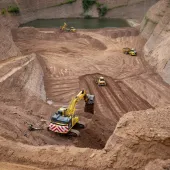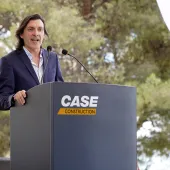Big push for Case dozer at Hillhead
Case Construction Equipment took the wraps off the first model in a new line of crawler dozers for Europe at this year’s Hillhead show (22-24 June). The mid-size dozer is suitable for both precision grading and heavy-duty earthmoving applications, with a high performance hydrostatic drive system, allowing full power turns for maximum productivity.
A Tier 3 certified Case 6.7-litre engine provides the power for the Case 1650L, and also for a smaller second machine that will follow, called the 1150K Series 3. A net output of 144hp (107kW) and 669Nm of torque is available in the larger Case 1650L, while the 1150K will get 118hp (88kW) with peak torque of 567Nm. In both cases peak torque arrives at just 1,400rpm, and has been developed for powerful low down torque characteristics, suitable for dozer applications.
The engine power is sent to the tracks through a dual-path PowerStat hydrostatic transmission, using variable axial piston pumps and motors to provide a maximum drawbar pull of 275.1kN in the larger machine and 213.5kN in the 1150K. As the transmission delivers drive to each track independently, it is possible to continue to push at full power throughout a turn, offering the operator maximum control for fine grading and for slope work.
The transmission has a single joystick control and the operator can choose infinite speed adjustment up to 9.7km/h, or opt for one of 10 pre-set speed settings, to suit the application.
The machines benefit from an isolation-mounted cab that offers low noise and vibration levels with a spacious environment for the operator. A narrow, advanced instrument cluster is mounted in front of the driver, with clear lines of visibility to either side of the blade and to the tracks. The engine canopy and nose section are also tapered to further improve visibility to the working area.
The operator has a clear view down to towed equipment at the rear of the machines, or to a choice of ripper attachments. If fitted, the standard ripper offers a maximum 483mm of cutting depth, with up to five ripper shanks in use on the 1650L and three shanks for the smaller model.
The cab is air-conditioned and features a deluxe air suspended seat, to provide all-day comfort for the operator. Single-lever drive control provides infinitely adjustable direction and speed control for precision grading. Low-effort blade controls further reduce fatigue for the driver.
Customers have a choice of three undercarriage configurations to meet their operating requirements on either model. These include the 1650L XLT extra-long track, with a 1.87m track gauge and 610mm track shoes; the 1650L WT wide track, with a 2.13m gauge and 711mm wide shoes; and the 1650LGP low-ground-pressure machine, which comes with the longer 2.13m gauge and 864mm wide track shoes.
Ground pressure varies from the XLT at 42.8kPa, to the WT at 38.7kPa and the LGP undercarriage, which puts down just 31.9kPa. All models use the Case Lubricated Track system, which is sealed and lubricated with an oil reservoir in each pin. An optional Case Extended Life Track, with a second hardened bushing, is available for abrasive soil conditions.
Given the additional traction of the larger undercarriage models, the 1650L XLT comes as standard with a 3.2m blade width, with an SAE capacity of 3.1m3. The WT machine has a wider 3.98m blade, though with the same 3.1m3 capacity, while the LGP model uses the wider 3.98m attachment with a 3.2m3 capacity.
For the 1150K the XLT has a track gauge of 1.78m with a 610mm shoe, offering ground pressure of 39.7kPa. The 1150K WT uses a 1.98m track gauge with 762mm width shoes and puts down 34.5kPa. Finally, the 1150K LGP offers the 1.98m gauge with 864mm wide track shoes, creating ground pressure of 29.2kPa. Blade widths range from 3.05m on the XLT to 3.35m on the other two machines, offering capacities of 2.9m3 and 3.2m3 respectively.
Ground level access panels put all daily checks and regular service points within easy reach. Swing-out doors and spin-on filters cut service times, while quick-connect diagnostic ports make troubleshooting a simple task.
For more in-depth maintenance and repair of the driveline, electric and hydraulic components, the entire cab structure can be tilted to one side of the machine in less than 10 minutes, providing unrivalled access.









